Playing kalimba is such a liberating activity! You seemingly have nothing but good choices in front of you. You can really cut loose and do whatever you want. Often, it works very well, because most kalimba tunings make success highly probable. And it’s really fun to just let things flow.
You can also make great progress on the instrument by developing a new awareness – paying careful attention to something you love that you just came up with while playing, and then playing it again and again.
In my own experience, when a real gem (spontaneously or otherwise) comes to me on kalimba, I start out by NOT thinking much about it, just doing it, and repeating enough so that my body really knows it. Only then do I bring my mind on board to study what my thumbs have been doing.
After I begin to think, I quickly notate the song in tablature so I can capture this gem of a song. Then I can play it any time in the future, no regret for being too lazy to catch a beautiful inspiration.
Kalimba tablature is a map of the kalimba upon which you can capture your music. Each column in the tablature represents a different tine. Notes are placed into those columns, starting from the column’s bottom and moving upward, to indicate which tines are to be played.
Even if you don’t read and write standard musical notation, you can still make marks on the various columns to remind you of which order to play the tines. There are no real rules, and if you are diligent, you will come to be able to read your own notations.
Below are little samples of the blank tablature for several different types of kalimba, including models with 8, 9, 10, 11, 15, and 17 notes. When you click on one of the images of blank tablature, or a “Download PDF” button, you will access the full page, multi-column PDF of blank tablature for that specific kalimba. Save this to your computer and print it out. You can make your own marks on the blanks, so you can notate the music you create yourself, and come back to it tomorrow and keep working on the same song. If you are savvy with computer or graphics, you can probably import these PDFs into your favorite graphics program and drop in your own note symbols.
The relative lengths of the tines in the footer (the bottom of the tablature) represent the tuning of each instrument. The footer will look exactly like the kalimba for which this tablature was made. This means when you look at your kalimba and look at the tablature’s footer, the tine lengths should match. This makes it easier to transfer a note from your kalimba to the tablature and vice versa. The kalimba’s painted tines show up as shaded columns, but if that kalimba has two rows of tines, it will have no tines painted, and in the tablature the upper row/shorter tines are shaded and regularly alternate with the longer tines.
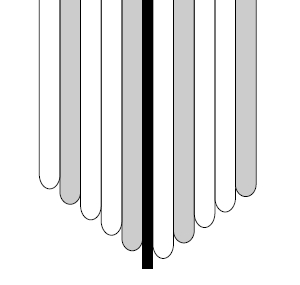 There are several new brands of Chinese-made 10-Note kalimbas. The instruments are very similar. The tablature here displays four painted tines, and this is how the tablature appears in our four eBooks for the 10-Note kalimba.Download Tablature PDF
There are several new brands of Chinese-made 10-Note kalimbas. The instruments are very similar. The tablature here displays four painted tines, and this is how the tablature appears in our four eBooks for the 10-Note kalimba.Download Tablature PDF
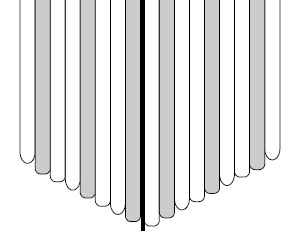
There are several new brands of Chinese-made 17-Note kalimbas. The instruments are very similar. The tablature here displays six painted tines, and this is how the tablature appears in our three eBooks for the 17-Note kalimba.
If you choose to paint your tines the way April Yang does in her demonstrations with five painted tines, you can use the “Treble Kalimba Tablature” (see below).Download Tablature PDF
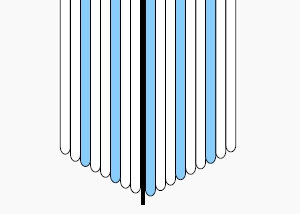
The blue columns in the tablature represent the five painted tines on the Treble kalimba, and the thick black line represents a logical break between the left and right sides of the instrument. (This tine-painting scheme is what April Yang uses in her YouTube demonstrations of 17-Note in C with five painted tines and not the six painted tines that I use in my 17-Note materials.)
This tablature will not work for Bb or D Trebles, which have different tines painted.
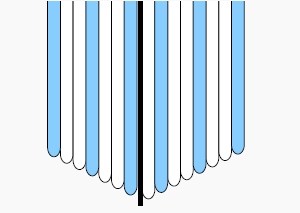 The Alto tablature indicates the six painted tines on the Alto kalimba. The black line represents a logical division between the left and right side notes – that is, the lowest, longest note in the center of the Alto kalimba is played by the right thumb.Download Tablature PDF
The Alto tablature indicates the six painted tines on the Alto kalimba. The black line represents a logical division between the left and right side notes – that is, the lowest, longest note in the center of the Alto kalimba is played by the right thumb.Download Tablature PDF
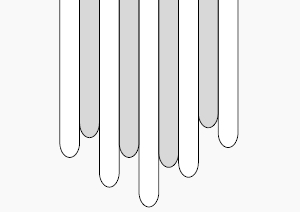 The gray tines on the Sansula tablature represent the upper-row tines which are shorter and bent upward. There are several alternative tunings available for the Sansula, and this tablature works with any of them.Download Tablature PDF
The gray tines on the Sansula tablature represent the upper-row tines which are shorter and bent upward. There are several alternative tunings available for the Sansula, and this tablature works with any of them.Download Tablature PDF
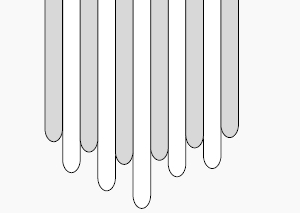 The upper tines on the B11 are indicated by the gray columns.Download Tablature PDF
The upper tines on the B11 are indicated by the gray columns.Download Tablature PDF
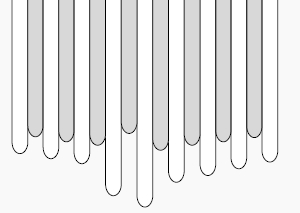 The Hugh Tracey 17-Note African-tuned Karimba has nine straight tines, and eight shorter tines bent upward interspersed among the long tines. The long, lower row tines are represented by white columns and the upper row tines are represented by shaded columns.Download Tablature PDF
The Hugh Tracey 17-Note African-tuned Karimba has nine straight tines, and eight shorter tines bent upward interspersed among the long tines. The long, lower row tines are represented by white columns and the upper row tines are represented by shaded columns.Download Tablature PDF
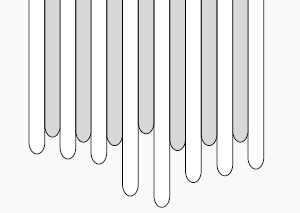 There are several karimba makers who make a karimba called the mbira nyunga nyunga that has 15 notes. The upper-row notes of the karimba are represented by the gray columns.Download Tablature PDF
There are several karimba makers who make a karimba called the mbira nyunga nyunga that has 15 notes. The upper-row notes of the karimba are represented by the gray columns.Download Tablature PDF
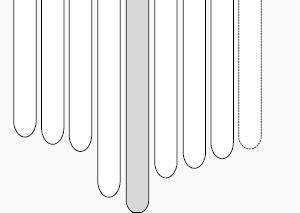 The Student Karimba is an 8- or 9-note instrument arranged like the lower row of notes in the 17- or 15-Note African Karimba. The gray tine in the center of the tablature represents the low central tine, which can be played by either the left or the right thumb. The far-right tine is shown with a dotted line to indicate that it may or may not be present on your instrument. If the 9th tine is present, it duplicates the tine 3rd from the left. This instrument is of great interest to me because it is what Andrew Tracey hypothesizes to be the “original mbira” and the “kalimba core,” at the root of the design of many southern African traditional mbira (instruments), and also because it’s at the root of the kalimba’s deep history.Download Tablature PDF
The Student Karimba is an 8- or 9-note instrument arranged like the lower row of notes in the 17- or 15-Note African Karimba. The gray tine in the center of the tablature represents the low central tine, which can be played by either the left or the right thumb. The far-right tine is shown with a dotted line to indicate that it may or may not be present on your instrument. If the 9th tine is present, it duplicates the tine 3rd from the left. This instrument is of great interest to me because it is what Andrew Tracey hypothesizes to be the “original mbira” and the “kalimba core,” at the root of the design of many southern African traditional mbira (instruments), and also because it’s at the root of the kalimba’s deep history.Download Tablature PDF
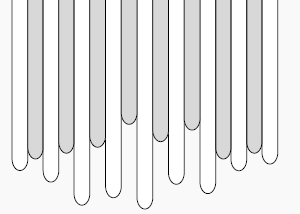 The Lotus Karimba tablature looks a lot like the 17-Note African-tuned Karimba tablature. The only difference is the footer, which represents the tuning of the Lotus through the relative length of the tines. The gray tines represent the upper, shorter notes.Download Tablature PDF
The Lotus Karimba tablature looks a lot like the 17-Note African-tuned Karimba tablature. The only difference is the footer, which represents the tuning of the Lotus through the relative length of the tines. The gray tines represent the upper, shorter notes.Download Tablature PDF
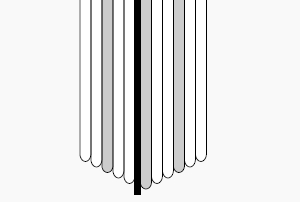 The Hugh Tracey Pentatonic Kalimba has 11 notes covering two octaves. There are several alternative tunings, and some span more than two octaves. The black line logically separates the left and right sides. The gray tines on the tablature represent painted tines.Download Tablature PDF
The Hugh Tracey Pentatonic Kalimba has 11 notes covering two octaves. There are several alternative tunings, and some span more than two octaves. The black line logically separates the left and right sides. The gray tines on the tablature represent painted tines.Download Tablature PDF
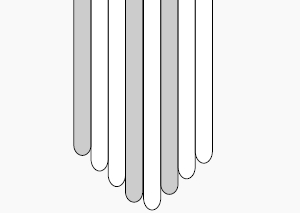 The 8-Note kalimba covers one octave. The gray columns represent painted tines. it is painted the same way as the lower eight notes of the Alto kalimba (on which G is standard tuning), however the 8-Note is usually in C. It is possible to retune the simple 8-Note and then use the same music that the Alto does, or to play along with the Alto.Download Tablature PDF
The 8-Note kalimba covers one octave. The gray columns represent painted tines. it is painted the same way as the lower eight notes of the Alto kalimba (on which G is standard tuning), however the 8-Note is usually in C. It is possible to retune the simple 8-Note and then use the same music that the Alto does, or to play along with the Alto.Download Tablature PDF
If you have any doubts about the utility of kalimba tablature, or you don’t quite understand how to use it, watch this video and see how the tablature on the left translates into music played on the kalimba on the right.
The tablature in the video shows one of the wonderful features of the program KTabS, (Kalimba Tablature Software), where you can have the program play back a song that you have just written. If you want to step into the kalimba world in a big way, instead of writing out your tablature by hand on blank tab sheets, you may want to get the KTabS program.


Sign up for our newsletter and free resources with your email address:
We pinky promise not to spam you and to only send good stuff.
 Christmas in July 2025
Christmas in July 2025 Patriotic and American Music for Kalimba
Patriotic and American Music for Kalimba